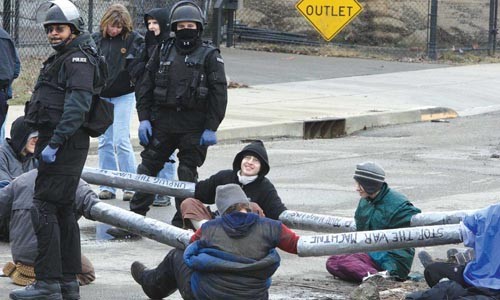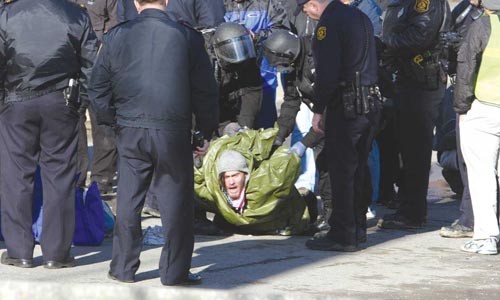(Click here to read a companion piece to this story, Political Veteran.)
When the first Carnegie Mellon University police officer arrived at CMU's National Robotics Engineering Center in Lawrenceville at 5:12 a.m., two groups of anti-war protesters were already in place.
It had taken just five minutes for Pittsburgh Organizing Group to set up their March 2 blockade. The action targeted both the front and rear entrances of the three-block-long facility, which was built in large part with Department of Defense contracts that aid the Iraq war.
Until now the NREC has attracted scant attention, despite its cutting-edge role in robotics research with military application. As a POG's statement explained, "[T]his action was intended to interject an anti-war message at a war-related facility that has thus far received no public scrutiny." And just as the work inside the building focuses on new technology, the protest outside the building employed new tactics.
Fourteen protesters lay in 43rd Street, blocking access to the back gate, each one hooked to the next. They had chains on their wrists attached to bolts drilled through the center of 3-to-4-foot lengths of PVC pipe. Known as lock boxes or "sleeping dragons," the pipes were covered with layers of chicken wire, tar and duct tape, making it difficult for anyone to cut through them. The line of protesters was wrapped around a telephone pole at one end; at the other end, an activist was hooked to NREC's fence by a bicycle U-lock.
In front of NREC, another activist had a U-lock around her neck and through the facility's small pedestrian gate, while five more protesters blocked the main vehicle gate, strung together using the same PVC devices. In front of them, at the head of NREC's short driveway, POG member De'Anna Caligiuri was slung some 20 feet in the air from a harness at the apex of three metal pipes. The tripod braced by other protesters.
The blockade, begun nearly three hours before its announced start, escalated a years-long anti-war campaign by POG that had mostly targeted military recruiting stations. The action attracted participants from surrounding counties as well as Cleveland and Athens, Ohio, Chicago, Baltimore and Washington, D.C.
Initially, Pittsburgh police offered to let news crews through to the scene if the protesters would voluntarily unlock themselves, but those lying in the street refused. Apart from a news helicopter, no other news crews arrived before 7:45 a.m., by which time police had already pushed observers back half a block.
While the front group drew minimal police attention, officers continued to threaten arrest for those strung across 43rd Street. "We've had a crew training on defeating these sleeping dragons -- they're very easy to defeat," city police Assistant Chief William Bochter warned the rear-gate protesters at 6:37 a.m.
"I've been teaching it nationally" as part of the Department of Homeland Security since 2003, explained Monroeville Borough Assistant Chief of Police Doug Cole, who was on the scene. "I was a source of information for the City of Pittsburgh. I have seen these devices before in numerous situations ... and we were prepared for them."
Even so, it would be 10:10 a.m. before police using manual and power tools were able to cut and chisel the last of the 14 activists in back of NREC out of the devices. One pair of protesters had unhooked from their bolt but re-hooked to each other, causing further delays. All 14 protesters at the back gate were arrested, including one minor; those at the front unhooked themselves at noon.
Beth Pittinger, head of the Citizen Police Review Board, said her police oversight group found nothing that would "cause concern" about police actions during the event and had received no complaints. The CPRB had two observers on 43rd Street.
Those arrested were charged with disorderly conduct, obstructing traffic and possession of an instrument of crime: "the homemade devices," explained city police spokesperson Diane Richard.
"That's a new charge for demonstrations. It's actually a pretty unusual charge," says attorney Mike Healey, who will be defending the arrestees. The misdemeanor charge is usually applied to such things as tools used in a break-in. Healey believes the cases "are defensible," although as of March 5 he had yet to interview the defendants or receive the court papers.
In interviews before the protest, participants said they hoped their move caused others to realize the connection between academia and the war.
"We need to confront all of the pillars that prop up the military system," said Patrick Young, of Lawrenceville, who was a liaison between protesters and police at NREC's front gate. "That includes decision-makers in Washington, that includes the recruiters and that includes people who develop and produce weapons systems. What we need now are people to take actual risks and take action to confront it and stop it."
"I've never been involved in anything like this before," said Mary Ruth Aull, of Penn Hills. But she was down at NREC shouting slogans through a bullhorn. "I didn't even know the place was there. I'm a retired home-care nurse. I did work in that area. I know I for one have been educated" by the protesters, although she has long sympathized with their cause. "I'm against the war and I'm against the empire -- the United States invading anywhere they want any time they want for any resources they want. ... We've got to start [objecting] somewhere. ... It's in the neighborhood."
Marie Skoczylas, of Bloomfield, helped with a rally and march that began in Friendship Park that morning. She cheered on the protesters once the 50 or so marchers arrived at NREC. "One thing I've noticed has been absent in recent years are large-scale actions that directly confront institutions," Skoczylas said. "It's time to move from protest to resistance" that "directly challenges war profiteers. ... It's going to take a lot more than what we're doing."
The protest was enough to disrupt activity for a day, at least. A few cars approached the building during the early morning, but then turned around. It appeared that the building was largely unoccupied on March 2.
"The action succeeded beyond the organizers' expectations," POG said in a March 3 statement.
Carnegie Mellon downplays the significance of NREC's military involvement.
"The U.S. military is one group that can use and benefit from robotic technologies," wrote CMU spokesperson Teresa Thomas in an e-mail after the protest, "but the potential applications for these same technologies ultimately are much broader in the private and commercial spheres. For example, robotic technologies already are assisting surgeons in the operating room and increasingly are making cars safer by providing assistance to the driver."
Plus, she added, "[W]e are developing robotic technologies that will save lives by keeping soldiers out of harm's way. Robotic vehicles, for instance, would reduce the need for human drivers of supply vehicles that are vulnerable to mines or ambushes."
But nine of 21 projects listed on the center's Web site are sponsored by the Pentagon, including seven by DARPA, the Defense Advanced Research Projects Agency, the DoD's central research arm. They include unmanned ground vehicles for the Army's "Future Combat Systems" program "needed to successfully perform tactical missions," the site says.
"The United States Army has set an ambitious goal of having one third of its ground vehicles be unmanned by the year 2015," NREC notes. Such robots are already being used for scouting and bomb disposal. NREC's programs "are advancing work on other autonomous vehicle programs including the Armed Reconnaissance Vehicle (ARV) and the Autonomous Navigation System (ANS)."
For its Robotics Simulation Support project, NREC boasts of working on "intervisibility algorithms (which determine whether targets are visible to assets and assets are visible to threats)" -- presumably things, or people, the military wants to shoot or keep from getting shot. The project also aids the "Military Operation on Urban Terrain" program.
NREC boasts of being "the only organization that participated in all three phases" of the DARPA PerceptOR program, whose goal is to "improve the ability of unmanned ground vehicles (UGVs) to navigate autonomously." NREC has developed a small unmanned helicopter to provide overhead eyes for its vehicle, which has been tested at Fort Polk, La.
Most damning, according to POG, is NREC's involvement in developing such vehicles as the Dragon Runner, Gladiator and Crusher for DARPA, branches of the military and several large defense contractors.
According to NREC:
~Dragon Runner is "an ultra-rugged, portable, lightweight reconnaissance robot for use by the U.S. Marine Corps in Operation Iraqi Freedom (OIF) for urban reconnaissance and sentry missions." The device is "light enough to be carried in a soldier's backpack, and rugged enough to be tossed over fences and up or down stairwells." It is sponsored by the U.S. Marine Corps Warfighting Laboratory in Quantico, Va.
~Gladiator was developed "to support dismounted infantry and combat engineers operating forward of ground combat element units ... for remoting [sic] combat tasks in order to reduce risk and neutralize threats. [...] Tasks of primary interest include day/night reconnaissance; surveillance and target acquisition (RSTA); detection of nuclear, biological & chemical (NBC) agents; obstacle breaching and direct fire." It is sponsored by the Office of Naval Research.
~Crusher, weighing more than 6 tons, which "can comfortably carry over 8,000 lbs. of payload and armor" and "can climb 4-foot steps."
Proponents of the facility's work point to their development of technology to improve excavation, warehouse work, mining and container handling as well as medical imaging. NREC's 21 projects include such innocuous developments as an automated mowing robot for golf courses, sponsored by the Toro Corporation, as well as a Caterpillar-backed effort to automate "loading excavated material onto dump trucks," and a John Deere tractor re-worked into "an autonomous vehicle for spraying water in orchards."
Activist David Meieran says he has heard the argument before, "that here are these other fruits of the labor that will benefit society as a whole." But that, Meieran says, merely "sanitizes the real consequences of what this facility does in society: It is a major cog in the war machine."
In fact, he argues, "NREC presents a new and frightening vision ... of 'Future Combat Systems,' which introduces a new crop of social and moral implications.
"My frustration with CMU's military ties started when I was a graduate student" beginning in 1998. "Some of us call the place Carnegie Military University." For years, the institution has been among the top universities receiving defense funding. By 2003, as the Iraq war was about to start, Meieran left CMU, disturbed by what he terms the "callous indifference" of students and faculty to CMU's support for the war effort, "and in how quickly they flocked to the huge supply of funds that was coming out of the Pentagon."
Such funding then "becomes the norm" for academic scientific research, while "students develop the skills that are geared toward military contractors" who hire them, further extending the militarization of an educational institution. "Nobody thinks twice about it."
CMU's role in the Iraq war has parallels to the development of the atomic bomb as well as to the Cold War, he contends: "We are committing the same mistakes." Such "warfare robotics," in Meieran's term, "just completely defines warfare. It creates a condition called asymmetric warfare, where civilians are more likely to be targeted."
If we have a robot army, he says, what then is the enemy's recourse? "They can't fight the U.S. war machine, but they can go after civilians" through increased terrorism. "It's going to make us less safe, not more safe."
CMU's Thomas would not address the idea.
"And if we're not safe here," Meieran adds, look for "more and more repression at home" by local law enforcement and the Department of Homeland Security. He sees the Dragon Runner and Gladiator eventually used in U.S. cities, much as other technology has been passed down from the armed services to local law enforcement.
"You'll see it patrolling down the streets," he concludes. "That's the nightmare scenario that also motivates me to shine a light on NREC."
The spotlight is attracting at least some attention already. On the CMU campus, "People have been talking about the NREC protest," says Geoff Hollinger, a Ph.D. student at the school's Robotics Institute. "I would like to see the faculty and administration getting together and finding a position on" the ethical implications of military research. "These protests, I'm hoping, will compel them to look at what they're doing, and decide whether they should be doing it. And I would say there is a strong possibility that people's eyes are opening to this."
Hollinger himself has mixed feelings about military use of robots. On the one hand, he notes, "There are military applications that are compelling, like mine removal." And remote-controlled combat "takes the soldier out of the heat of battle, so he's able to make more rational decisions" -- saving his life and perhaps the lives of innocent civilians.
On the other hand, Hollinger says, "I do see a danger in taking the humans out of the battle completely. A lot of [anti-war] pressure is because people don't want their sons and daughters to go to war. If it's robots going to war, you might see the country going to war more willy-nilly."
In either case, Hollinger is "trying to open up a forum for discussion of issues that relate to the crossover between philosophy and robotics," including the ethical dimensions of work at NREC.
Still, attitudes won't change overnight, he says. "The reaction from most people I've seen is that this is just a little too crazy. People blockading and getting arrested is so far out there that they don't take it seriously."
That reaction doesn't surprise some protesters. Alecia Ott, a student at John Carroll University in Cleveland who was arrested at NREC's back gate, told City Paper before the protest that until recently, she too was puzzled by the sort of demonstration she was about to undertake. She recalls seeing the protest of an air show in Cleveland. "At first I thought, what the heck?" Then she soon realized that there was something amiss with war planes "being used for entertainment. It's part of a war mentality that we have.
"We're putting our bodies on the line," she said of her fellow protesters. "I hope they're shocked into doing something."
Chris Potter contributed reporting for this story.





















